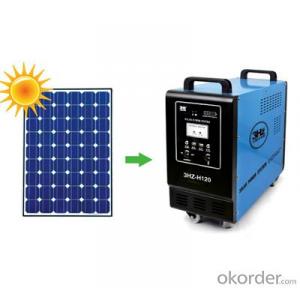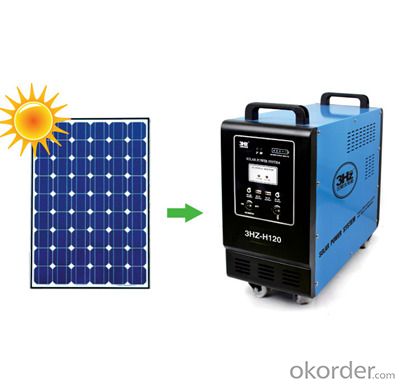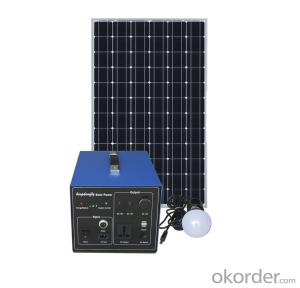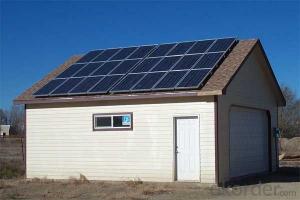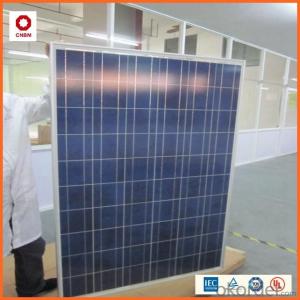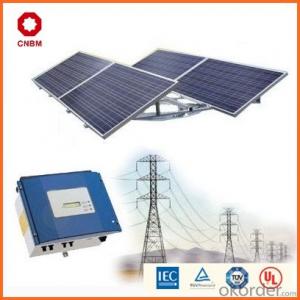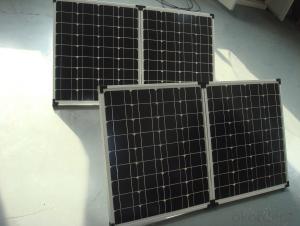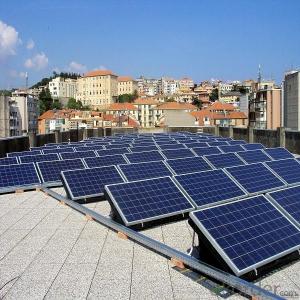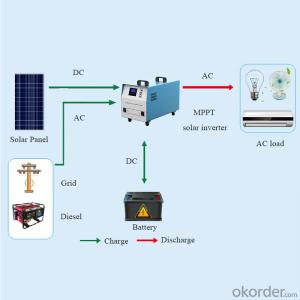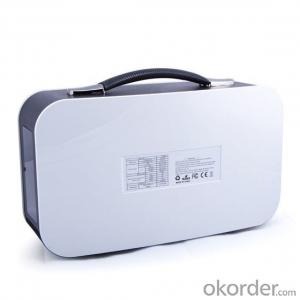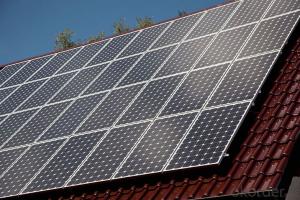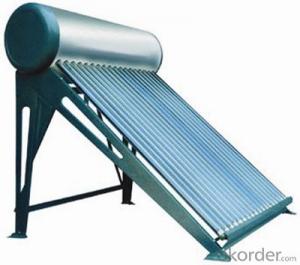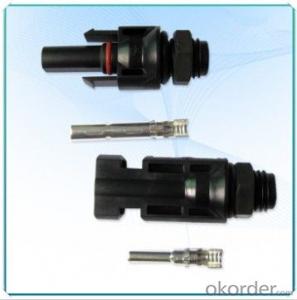150W Cheap Solar Energy Systems Portable Solar Power Generator
- Loading Port:
- China Main Port
- Payment Terms:
- TT OR LC
- Min Order Qty:
- -
- Supply Capability:
- -
OKorder Service Pledge
OKorder Financial Service
You Might Also Like
Specifications
1, 150W Solar Power System.
2, Power rating 300W for home devices.
3, Life span: 15 years.
4, Warranty: 12 months.
150W Solar Power System
1. Functions:
1) This model equipts with high efficiency charge and discharge controlling, over current protection.
2) Direct current output
a. Four plug contacts of DC12V / 20A output, could be used for DC lamp, DC fan, DC refrigerator, etc.
b. With DC9V / 30A and DC5.5V / 500mA output, could be used to charge cell phone, digital camera, music players, etc.
3) Alternating current output
Pure sine wave in 50Hz, continuous power 300W, peak power 600W, could be used to run household appliances like television, computer, fan, icebox, lights, etc.
4) LCD indicator
Showing battery voltage, battery capacity, charging current, inverter working states.
2. System configuration:
1) Poly or mono solar pane: 18V / 150W, 15 years lifespan.
2) Maintenance-free lead-acid batteries can be deep-discharge. 80AH, 12V, three-year lifespan.
3)Pure sine wave inverter. Input: 300W, output: AC 220V / 50Hz.
4) Controller: 12V, 20A
3. User manual:
1) Install the solar panel properly, and connect the solar panel by plug in ‘solar input’on the control box.
2) Operation panel manual
a. Controller’s working states will be showed on the LCD. First line: battery voltage. Second line: charging current. Third line: current battery volume. Fourth line: inverter’s working status.
b. Switch ‘power’ on to start controller, every output outlet works properly.
c. Start AC 220V output by switch ‘inverter’ on, which is fit for AC electrical appliances within 300W. Can be used for most of the digital products through an adapter.
d. It is recommended turning off the back screen light if you don’t need it by press ‘LCD Backlight, this will help to save the power.
4. Notes:
1) Output voltage and current are marked on the panel, overload is prohibited.
2) Keep this product away from rain or water.
3) Charge the battery for 24 hours before the first use, or the product may not work properly for running out of battery during long distance transportation.
3) When you got this product, please fully charge the battery before using. It may not work since over-discharge in long time transportation.
4) To change the battery, please note the battery cable prohibit reverse. Correct wiring should be: the red line connect with the battery anode, black one connects with the battery negative.
5) Please read this manual carefully before using
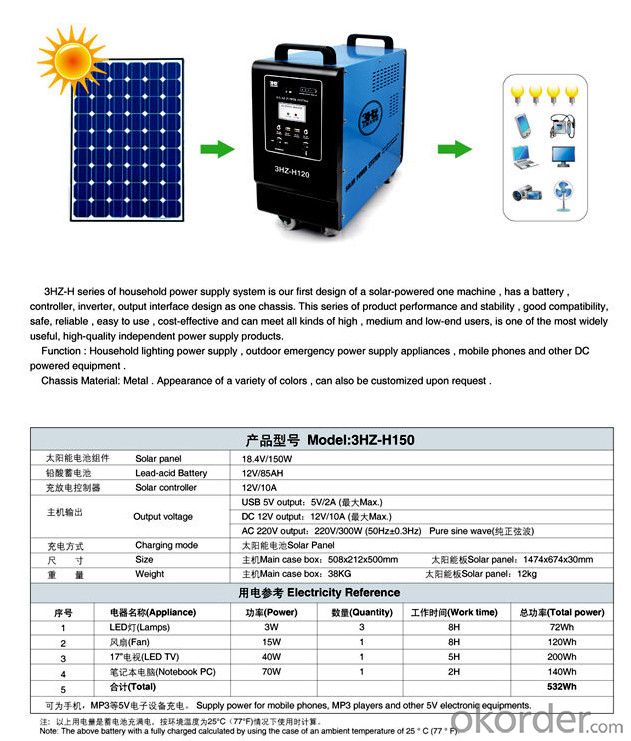
- Q: How do solar energy systems affect job growth in the renewable energy sector?
- Solar energy systems have a positive impact on job growth in the renewable energy sector. The installation, maintenance, and manufacturing of solar panels create numerous employment opportunities. Additionally, the growth of the solar industry prompts the development of related sectors, such as research and development, engineering, and sales, further contributing to job creation. Overall, solar energy systems play a significant role in fostering job growth within the renewable energy sector.
- Q: What is the impact of dust and dirt on the performance of solar panels?
- Dust and dirt have a significant impact on the performance of solar panels. When dust settles on the surface of solar panels, it forms a layer that obstructs sunlight from reaching the photovoltaic cells. This reduces the amount of light absorbed by the panels, resulting in a decrease in the overall energy output. The accumulation of dust over time can lead to a substantial reduction in efficiency, ultimately affecting the overall performance of the solar panel system. Furthermore, dirt and dust can also cause shading on the panels, creating hotspots. These hotspots can cause localized heating, leading to potential damage to the panel's electronics and reducing their lifespan. The elevated temperatures can also cause a drop in efficiency and further decrease the energy production capability of the solar panels. Regular cleaning and maintenance of solar panels is crucial to mitigate the impact of dust and dirt. Cleaning can be performed manually through periodic washing, or automated cleaning systems can be installed to ensure panels are kept free from debris. By maintaining clean panels, the amount of sunlight reaching the photovoltaic cells is maximized, optimizing energy production and ensuring the longevity of the solar panel system.
- Q: Can solar energy systems be used for emergency backup power during power outages?
- Yes, solar energy systems can be used for emergency backup power during power outages. Solar panels generate electricity from sunlight, which can be stored in batteries for later use. This stored energy can then be used to power essential devices or appliances during an outage, providing a reliable source of backup power.
- Q: How do I choose the right size of solar energy system for my home?
- To choose the right size of solar energy system for your home, you should consider your average electricity consumption, available roof space, and budget. Start by evaluating your monthly energy usage and determine the amount of electricity you want to generate through solar. Then, consider the size and direction of your roof to estimate how many solar panels can fit and receive maximum sunlight. Lastly, take into account your budget and financial goals to determine the size that aligns with your investment plans. Consulting with a reputable solar installer can also provide valuable insights and help you make an informed decision.
- Q: How do solar energy systems handle excess power generation?
- Solar energy systems handle excess power generation in a few different ways. One common method is through net metering, where any excess electricity produced by the solar panels is sent back to the grid and the homeowner or business owner receives credits for that excess power. Another approach is to store the excess energy in batteries, which can then be used during times when the solar panels are not generating enough power, such as at night. Additionally, some solar energy systems are designed to automatically adjust the tilt or orientation of the panels to reduce power generation when it exceeds the demand.
- Q: Do solar energy systems require a backup generator?
- No, solar energy systems do not necessarily require a backup generator. Solar energy systems primarily rely on sunlight to generate electricity, so as long as there is sufficient sunlight, they can produce power. However, it is important to note that solar energy systems are typically interconnected to the electrical grid, allowing excess energy to be fed back into the grid during times when the solar panels produce more electricity than is being used. This allows for a credit or compensation from the utility company, which can offset the cost of electricity when the solar panels are not generating enough power. In situations where a solar energy system is off-grid and not connected to the electrical grid, a backup generator or energy storage system, such as batteries, may be necessary to provide power during times when there is insufficient sunlight. This ensures a continuous power supply even in the absence of sunlight. Ultimately, the need for a backup generator depends on the specific setup and requirements of the solar energy system.
- Q: What is the ideal direction for solar panels to face?
- The ideal direction for solar panels to face is south (in the northern hemisphere) or north (in the southern hemisphere). This orientation allows the panels to capture maximum sunlight throughout the day, optimizing their energy generation.
- Q: How do solar energy systems impact job creation?
- Solar energy systems have a positive impact on job creation as they require skilled professionals for installation, maintenance, and operation. This industry's growth has led to the creation of various job opportunities, particularly in manufacturing, engineering, construction, and project management. Additionally, the widespread adoption of solar energy stimulates local economies, attracting investments and driving the need for more skilled workers, contributing to overall job creation.
- Q: What are the different applications of solar energy systems in transportation?
- Solar energy systems can be applied in various ways in transportation to reduce carbon emissions and dependence on fossil fuels. One application is in electric vehicles (EVs), where solar panels can be installed on the roof or hood of the vehicle to harness solar energy and charge the batteries. This can extend the range of EVs and reduce the need for charging from the electrical grid. Solar energy can also be used in charging stations for EVs. These charging stations can be equipped with solar panels to generate electricity and provide clean energy for charging EVs. This reduces the reliance on non-renewable energy sources and contributes to a more sustainable transportation system. Another application of solar energy systems in transportation is in public transportation. Solar-powered buses and trains can be used to provide emissions-free transportation options, reducing air pollution and improving air quality in cities. Solar panels on the roofs of these vehicles can provide power for various onboard systems such as lighting, air conditioning, and information displays, further reducing energy consumption. In addition to EVs and public transportation, solar energy systems can also be used in other modes of transportation such as bicycles and boats. Solar panels can be integrated into the design of these vehicles to generate electricity for powering electric motors or charging batteries, making them more energy-efficient and environmentally friendly. Overall, the applications of solar energy systems in transportation are diverse and offer significant potential for reducing greenhouse gas emissions and promoting sustainable transportation options. By harnessing the power of the sun, we can create a cleaner and greener future for transportation.
- Q: Can a solar energy system be used for charging electric vehicles?
- Certainly, electric vehicles can be charged using a solar energy system. Sunlight is captured by solar panels and transformed into electricity, which can be generated in places like rooftops, carports, or open areas. This clean and renewable energy can then power the charging of electric vehicles, eliminating the necessity for conventional fossil fuel-based charging methods. To meet the increasing demand for electric vehicles, solar-powered charging stations are being installed in various locations, including parking lots, highways, and residential areas. Utilizing solar energy for charging electric vehicles not only significantly reduces greenhouse gas emissions but also decreases our reliance on non-renewable energy sources. In this way, we contribute to creating a transportation system that is more sustainable and environmentally friendly.
Send your message to us
150W Cheap Solar Energy Systems Portable Solar Power Generator
- Loading Port:
- China Main Port
- Payment Terms:
- TT OR LC
- Min Order Qty:
- -
- Supply Capability:
- -
OKorder Service Pledge
OKorder Financial Service
Similar products
Hot products
Hot Searches
Related keywords
